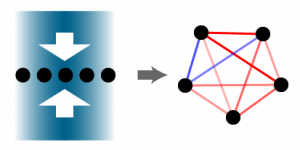Summary
Quantum simulators have the potential to bring unprecedented capabilities in areas such as the discovery of new materials and drugs. Engineering precise and programmable interaction graphs between qubits or spins forms the backbone of simulator applications. The trapped ion system is unique in that the interaction graph between qubits can be programmed, in principle arbitrarily. In the context of quantum many-body physics simulation, a programmable interaction graph will allow us to investigate a wide range of spin models relevant to condensed matter systems and high energy physics. In this project we investigate the feasibility of creating an arbitrary qubit-qubit interaction graph and experimentally characterize the interactions. The robustness of such graphs, including errors from experimental parameters, will be analyzed in collaboration with Roger Melko’s group. We will combine theoretical ideas from quantum information processing and many-body physics, numerical optimization and machine learning techniques, and experimental optical and atomic physics techniques.
This project will enhance the capability of trapped ion quantum simulators significantly beyond the state-of-the-art and will identify a set of concrete many-body physics problems that can be realistically simulated. Altogether these contributions will form an enabling step towards the scalability of a quantum processor.

Figure 1. Trapped ion qubits (black discs) are essentially a fully-connected system. The goal of this project is to engineer and characterize the qubit-qubit interaction graph (represented by the red and blue bonds) using precisely tuned laser beams (blue shades with white arrows).
Related Content
Fabrication of Ultra Low Noise RF SQUID Amplifiers
A superconducting quantum interference device (SQUID) is an extremely sensitive magnetic field detector.
June 1, 2017

Hybrid Quantum Repeater based on Atomic Quantum Memories and Telecom Wavelength Entangled Photon-Pairs Generated from Semiconductor Nanowires
Summary Losses in physical channels, such as optical fibres, limit existing quantum communication systems to modest distance ranges. Since amplification of quantum signals is fundamentally not possible, we look to extend the range and functionality of these quantum channels by adding quantum memory nodes that can daisy-chain multiple lengths of quantum channels through entanglement […]
October 29, 2018

Quantum Sensing with Small Quantum Systems
Summary There are small quantum systems over which we have very good control and which have long lifetimes. Examples include the phosphorous (P) defect in silicon (Si) and the nitrogen vacancy (NV) defect in diamond. With P defect in Si, we focus on improving our understanding of the hyperpolarization mechanism to better enable engineering of […]
December 1, 2016
Spin-transfer Torque Magnetic Random Access Memory for On-chip Spin Information Storage
Summary Leakage power in semiconductor memories, such as Dynamic Random Access Memory (DRAM) and Static Random Access Memory (SRAM), can be substantial and is one of the limits for scalability of classical electronics. This is attributed to the fact that the information stored is volatile, requiring constant refreshing, as well as reprogramming upon powering […]
August 6, 2018

